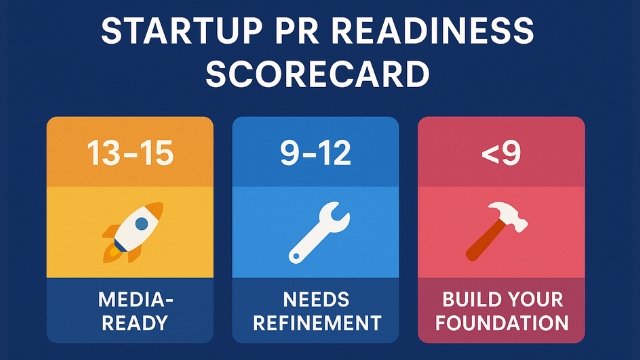Are You Actually Ready to Get Featured in the Media?
Public relations can feel like a mysterious superpower reserved for tech giants and Silicon Valley insiders — but in 2025, the playing field has changed. Startups of all stages now have more access than ever to journalists, creators, niche media, and influential platforms. But here’s the truth: just having a “great product” isn’t enough to land you a glowing headline in TechCrunch, Fast Company, or your industry’s top newsletter.
Media success starts before you ever hit “send” on that press release. It begins with PR readiness — having the right message, digital presence, story, and strategy in place. That’s where most founders fail. They launch a product, expect reporters to care, and get radio silence in return. Why? Because they didn’t do the foundational work.
This comprehensive guide is designed to be your go-to resource — the most detailed, brutally honest, and actionable PR readiness checklist for startups in 2025. Whether you’re an early-stage SaaS founder bootstrapping your launch or a Series A consumer brand preparing for a major rebrand, this is your roadmap.
We’re not just listing out to-dos. We’ll explain why each piece matters, how it affects your credibility, and what real-world PR success looks like behind the scenes. This isn’t theory — this is the same checklist top PR agencies and media strategists use before pitching a story.
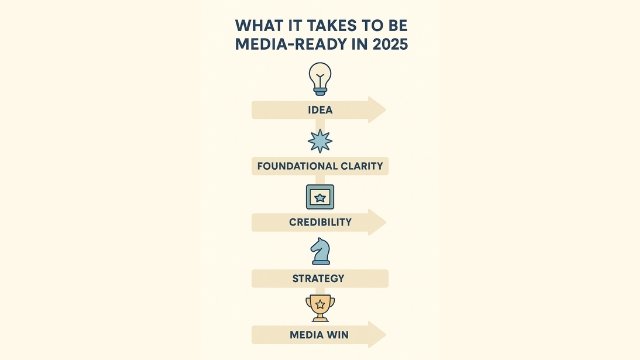
By the end of this post, you’ll be able to:
- Evaluate if your startup is truly media-ready
- Identify your blind spots and credibility gaps
- Align your PR goals with a strategic amplification plan
- Understand how to leverage media wins for long-term brand equity
Let’s begin with what matters most: your foundational clarity, because if you can’t explain your startup clearly, no journalist will do it for you.
1: Foundational Clarity
Can You Clearly Explain Who You Are and Why You Matter?
Before you ever pitch a journalist, send a press release, or tweet “Big news coming soon,” you need to ask yourself one thing: Can someone outside your company instantly understand what your startup does — and why it matters — in less than 10 seconds?
Foundational clarity is what separates a forgettable brand from a media-ready one. It’s not just about clarity for customers; it’s about making your story instantly compelling to outsiders, especially busy reporters, podcast hosts, creators, and analysts.
Let’s break this down into four mission-critical pieces:
1. Explain Your Startup’s Core Offering in 2–3 Sentences (No Jargon Allowed)
You’d be shocked how many founders can’t do this. What they think is a simple explanation is often a jargon soup of “AI-powered synergies for decentralized market re-alignment.” No journalist will quote that.
Here’s a PR-friendly rule of thumb for 2025:
“If your startup’s value prop can’t be explained clearly to a high school student, it’s too complicated for the press.”
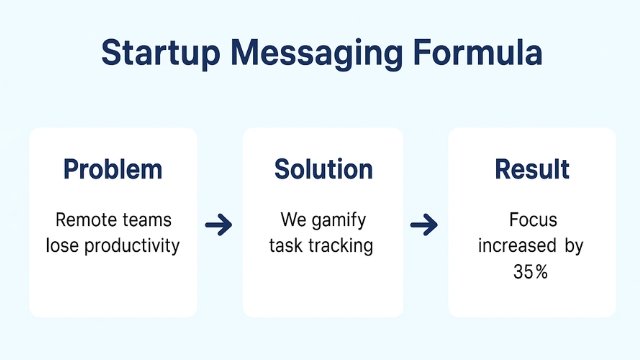
The fix:
Use the “Problem → Solution → Result” formula:
- Problem: What’s broken?
- Solution: What are you building?
- Result: Why does it matter now?
Example (2025):
“We help remote teams improve accountability using a gamified task tracking platform that rewards deep work. It’s like a Fitbit for your productivity stack.”
Notice how that’s simple, relevant, and paints a visual picture — that’s what catches editorial attention.
2. Do You Have a Compelling Founder Story or Unique Mission?
In 2025, people are the story, not just products. Media outlets are increasingly interested in founder journeys, resilience, vision, and values. Why did you build this? What makes your path worth reading about?
This is especially true in the era of AI-generated noise. Authenticity cuts through. Whether you’re:
- A second-time founder who pivoted after a failed exit
- A parent solving a problem your kid experienced
- A climate-focused entrepreneur with a mission to reshape waste
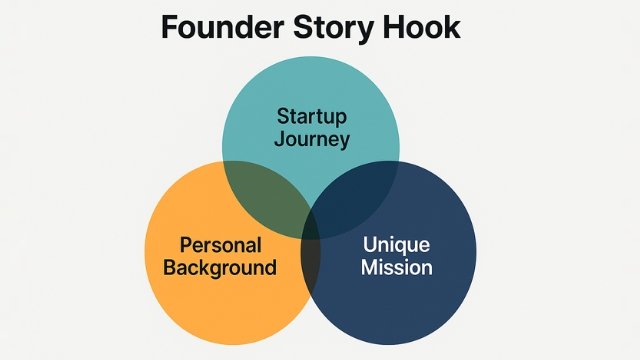
Your why matters as much as your what. Great founder stories create emotional hooks that journalists can build their narrative around.
Pro tip: Package your origin story in a way that aligns with:
- Personal transformation (e.g., “I left Google to fix this broken industry”)
- Underdog narratives
- Societal shifts (“COVID changed everything for us…”)
3. Is Your Value Proposition Connected to a Larger Trend or Social Impact?
Media coverage thrives on relevance. Your story is 10x more likely to get picked up if it connects to a current event, macro trend, or emerging shift in how people live or work in 2025.
Journalists don’t just ask, “Is this product good?” They ask:
“Why does this matter right now?”
Ask yourself:
- Are you tapping into the AI-for-good movement?
- Is your platform addressing burnout, digital loneliness, or climate anxiety?
- Are you building tools that help the 2025 creator economy grow more sustainably?
Example:
You’re not just a fintech startup. You’re solving Gen Z’s trust crisis in traditional banks by offering AI-powered, transparent budgeting tools.
Make it topical. Make it matter.
4. Have You Defined Your Audience and Key Messaging?
Clarity isn’t just external. You need internal alignment on who you’re talking to and what you want them to feel or do.
Before you even think about press outreach, answer:
- Who are your primary and secondary audiences?
- What 3 key messages do you want every piece of media coverage to communicate?
- What perception are you trying to build: Innovation? Trust? Category leadership?
This messaging becomes the foundation of:
- Your press kit
- Your founder interviews
- Your social posts amplify the story
If your messaging is inconsistent, journalists will either rewrite your story or ignore it.
Quick Check: Are You Foundationally Clear?
| Question | Yes / No |
| Can you explain your startup in 2–3 sentences, without jargon? | ✅ / ❌ |
| Do you have a unique founder story or mission? | ✅ / ❌ |
| Is your value prop tied to a trend or social issue in 2025? | ✅ / ❌ |
| Have you defined your audience and core message pillars? | ✅ / ❌ |
If you scored 4/4, you’re off to a strong start. Less than that? Time to tighten the narrative before knocking on media doors.
2: Online Presence & Credibility
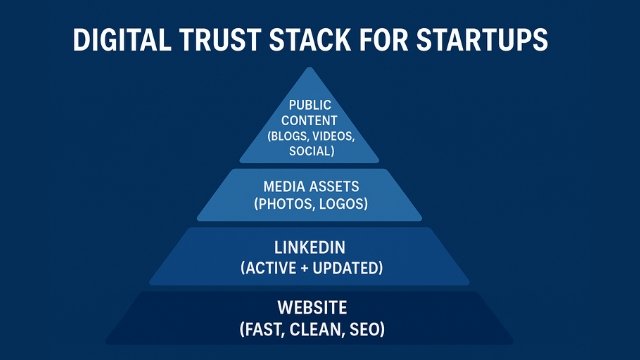
Would a Journalist Trust You Based on Your Digital Footprint Alone?
Imagine this: a reporter gets your pitch. The idea sounds promising. But before replying, they do what every journalist does in 2025 — they Google you. What they find (or don’t find) determines whether you ever hear back.
Your online presence is your instant credibility filter. In a world of AI-generated noise, deepfakes, and cloned brand personas, credibility signals are the currency of trust. This section ensures you’re not just visible, but trustworthy.
Let’s dig into the 2025 expectations for PR-ready digital presence:
1. Does Your Website Look Professional, Load Fast, and Follow SEO Best Practices?
Your website is not just a landing page — it’s your proof of existence.
When a journalist lands on your homepage, they subconsciously ask:
- Is this company real?
- Are they serious?
- Would my readers trust this brand?
Here’s what “professional” means in 2025:
- Clean, responsive design across devices
- Load speed under 2.5 seconds (Core Web Vitals still matter)
- Clear, non-bloated copy with proper heading structures (H1, H2, H3)
- Meta tags, alt attributes, and schema markup are properly implemented
- A working About and Contact page with a real human name
Bonus SEO Tip: Use your blog and homepage copy to rank for keywords tied to your niche + media intent. For example:
- “AI scheduling tool for remote teams”
- “Fintech startup helping Gen Z save”
- “Affordable carbon tracking for SMBs”
PR insight: If your website looks like it was built in a weekend, no major outlet will link to it.
2. Is Your LinkedIn Company Page Active and Accurate?
LinkedIn is still the #1 professional validation platform in 2025. Before journalists reach out, they’ll often:
- Check your founder profile
- Look at your team
- See if your company page is current and active
Your company’s LinkedIn should:
- Reflect your most recent description
- Include media logos or social proof (if any)
- Share occasional updates (product launches, milestones, etc.)
- Tag key employees to show legitimacy
And if you’re solo? Your personal LinkedIn must be strong.
Think: updated headshot, clear headline, real experience, featured links. Use your About section to pitch the human behind the product.
3. Do You Have High-Quality Logos, Founder Photos, and Product Visuals?
One of the biggest mistakes early-stage startups make? No press-ready assets.
In 2025, media outlets (and even influencers) want visuals they can quickly drop into a post, reel, or article. That means:
- A clean logo in transparent PNG and vector (SVG) formats
- A high-res founder headshot (professional, not your iPhone selfie)
- Screenshots or demo images of your product in use
- Lifestyle or team photos that tell a story
- A one-click download link in your press kit or Notion hub
Why it matters:
Every extra step a journalist has to take = a higher chance they drop your story.
Pro tip: Host your media kit on a clean Notion page, Google Drive, or custom URL like /press.
4. Have You Published Content That Aligns With Your Brand Voice?
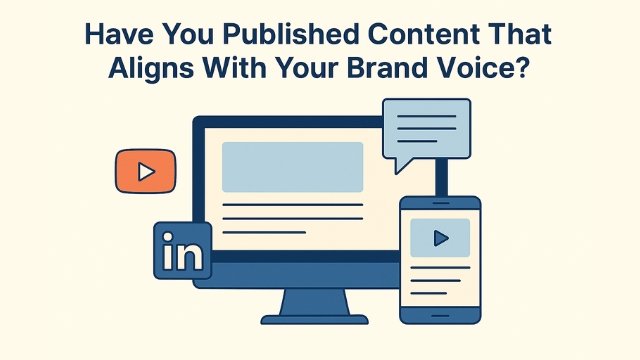
Your voice is your brand’s personality — and it should show up online.
If a journalist or podcast host wants to know how you think, they’ll check:
- Blog posts or LinkedIn articles
- Twitter/X or Threads presence
- YouTube Shorts or podcast interviews
- Any Medium/Substack guest posts
You don’t need to go viral. But you do need to show that you’re a thinking founder, not a ghost. Even a short LinkedIn post about your market, mission, or lessons learned can establish credibility.
Brand alignment tip:
Every piece of content should reinforce your startup’s key messaging pillars. Don’t go off-brand just to chase trends — that’s confusing to media gatekeepers.
Quick Check: Is Your Digital Presence PR-Ready?
| Question | Yes / No |
| Does your website look professional, fast, and SEO-optimized? | ✅ / ❌ |
| Is your LinkedIn page or personal profile active and up to date? | ✅ / ❌ |
| Do you have downloadable logos, founder headshots, and product visuals? | ✅ / ❌ |
| Have you published any branded content in your voice? | ✅ / ❌ |
Scored 4/4? You’re ahead of 90% of early-stage startups.
Less than that? Start polishing now — credibility is earned before you’re in the spotlight.
3: Media Strategy Readiness
Are You Pitching with Purpose — or Just Hoping for Luck?
Once you’ve nailed your messaging and online presence, it’s tempting to start pitching every journalist you can find. But here’s the reality in 2025: Spray-and-pray PR doesn’t work. Journalists receive hundreds of pitches per week — many of them from startups who are “launching something cool” but don’t explain why it matters.
To rise above the noise, you need a crystal-clear strategy. What’s your goal? What’s the actual story? Who are you telling it to? And why should they care now?
Let’s walk through the core components of a PR strategy that actually gets coverage.
1. Do You Have a Specific Goal for PR?
This might sound obvious, but it’s where many founders fail: they want “PR,” but can’t articulate why. Your PR objective will shape every tactic and message.
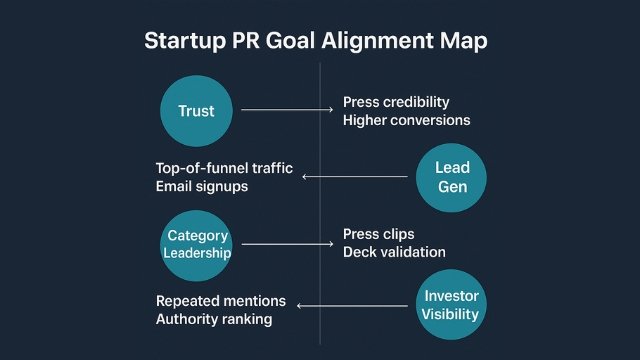
In 2025, the most common startup PR goals include:
- Trust building: You want potential users or customers to feel safe betting on your brand.
- Investor visibility: You’re raising a round and want to increase credibility or warm up VC interest.
- Recruiting leverage: You want talent to see you as an exciting, mission-driven company.
- Category creation or leadership: You’re defining a new space and want to own the narrative.
- User acquisition: You’re launching and need volume — fast.
Each goal requires a different tone, outlet, and distribution plan. If you can’t define your primary PR objective, stop and clarify before pitching.
Pro tip: “Get press” is not a goal. “Establish credibility with pre-seed VCs in climate tech” is.
2. Can You Identify What’s Actually Newsworthy?
Here’s the brutal truth: most startup news is not newsworthy.
Journalists don’t cover “just launched” unless:
- You’re solving a hot or widely felt problem
- You’re backed by someone notable (Y Combinator, top VC, famous founder)
- There’s a cultural or industry tie-in
To determine if your story is newsworthy, ask:
- Why now? What’s timely or urgent?
- What’s new? What hasn’t been done before?
- Who cares? Would anyone outside your team be impacted or intrigued?
Examples of angles that are newsworthy in 2025:
- “We’re the first platform to help creators calculate their AI-generated revenue losses.”
- “Our startup just secured funding to create the world’s first biodegradable home battery.”
- “After being laid off from OpenAI, I built a tool to detect AI-generated lies.”
If you can’t find the hook, the media won’t either.
3. Do You Have a Draft Press Release or 3 Key Talking Points?
Whether or not you’re planning to publish a formal press release, you must be able to hand a journalist the raw material for their story.
At a minimum, prepare:
- 3 strong talking points about your product, founder story, and market relevance
- A prewritten quote from the founder or customer
- Clear data or milestones (e.g., revenue growth, user count, social proof)
- Contact info and media assets (see Section 2)
A good press release follows this structure:
- Headline + subhead with impact
- Who, what, when, where, why — in the first paragraph
- Quotes, context, and proof points
- Boilerplate about your company + media contact
Bonus: Create a Notion-based press kit where journalists can grab everything in one click.
4. Have You Researched and Identified Relevant Publications or reports?
One of the biggest PR sins in 2025? Pitching the wrong person.
Journalists don’t cover everything. They cover beats. That’s their niche — and if your pitch doesn’t align, it goes straight to the archive.
To do it right:
- Use tools like Muck Rack, Prowly, or Twitter/X to see what reporters are writing about
- Create a list of 10–15 high-fit outlets and specific writers
- Personalize your pitch based on a recent story they published
- Include a compelling subject line, short body, and clear CTA (interview, quote, coverage, etc.)
Avoid:
“Hey Tom, I love your work. We’re launching something exciting. Would you be open to covering us?”
Try instead:
“Hi Emma, I saw your recent piece on carbon transparency in e-commerce. We’re launching a product that automates compliance with the new EU carbon disclosure regulations. Happy to send more context or schedule a quick demo.”
That’s relevant. That gets replies.
Quick Check: Is Your Media Strategy Ready?
| Question | Yes / No |
| Do you have a clear and measurable PR goal? | ✅ / ❌ |
| Can you explain what’s truly newsworthy about your story? | ✅ / ❌ |
| Do you have a press release draft or 3 talking points? | ✅ / ❌ |
| Have you identified and researched relevant journalists/outlets? | ✅ / ❌ |
4/4? You’re ready to start pitching like a pro.
3 or fewer? Hit pause and sharpen your angle — the shotgun approach will backfire.
4: Amplification Plan
What Happens After You Get Featured? (Hint: That’s When the Real Work Starts)
Too many startups treat press coverage like a finish line. You got featured — congrats! But here’s the hard truth in 2025: one media hit isn’t the goal. Long-term visibility is. If you don’t amplify it, even a great piece can vanish into the digital ether within 48 hours.
The smartest founders don’t just celebrate press — they weaponize it across every channel. This is how you turn one article into brand equity, social proof, investor momentum, and evergreen trust.
Let’s break down exactly how to do that.
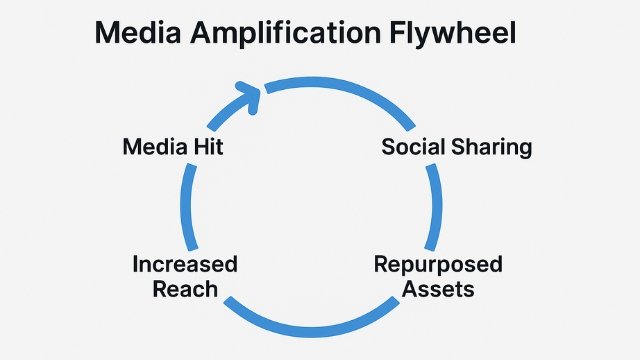
1. Do You Have a Plan to Share the Coverage Across All Owned Channels?
Think of the press as the spark — your job is to turn it into a fire. Once the piece goes live, you should have an amplification plan ready to roll out across:
a. Website
- Add an “In the Press” section
- Update your homepage banner or announcement bar
- Add the outlet logo (with permission) to your footer or feature block
- If you’re quoted, pull a soundbite and feature it as a trust-builder
b. Email
- Share the press hit in your next newsletter
- If you’re launching, send a “We’re Live!” update with a link to the article
- Include a soft CTA (e.g., join waitlist, sign up, refer a friend)
c. Social Media
- Don’t just repost the link — add context:
“Honored to be featured in @FastCompany today — here’s what we shared about solving remote burnout in Gen Z teams ”
- Create 2–3 content variants per platform (LinkedIn, X/Twitter, Threads, Instagram)
- Tag the journalist and the outlet (when appropriate)
2. Will You Repurpose the Coverage Into Other Strategic Assets?
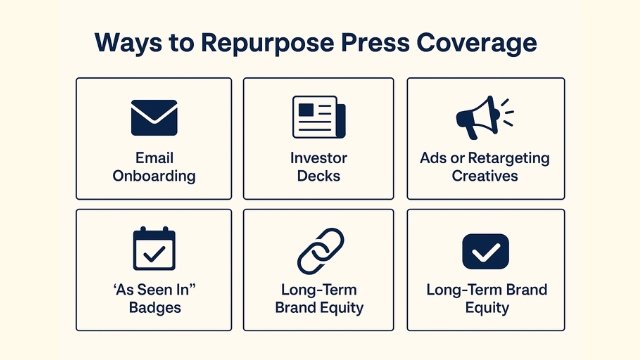
This is where amplification turns into leverage. You can stretch one media win across dozens of marketing and sales touchpoints:
a. Email Onboarding Sequences
- Insert a quote from the article into your welcome email
- Add: “Recently featured in YourStory” as a credibility nudge
b. Investor or Partner Decks
- Include logos from top-tier or niche outlets
- Quote a headline or soundbite to build trust
- Add a screenshot with a caption like: “Recognized as one of the top startups to watch in 2025.”
c. Paid Ads / Retargeting Creatives
- Use the feature to build authority in cold traffic
- Test variations like: “As seen in Forbes” in your ad banners
- Combine UGC with third-party validation for a powerful blend
d. Hiring Pages
- Add coverage to your “Careers” section to signal legitimacy and culture
- Show prospective hires that your story is being recognized externally
3. Are You Using “As Seen In” Logos and Badges Strategically?
This tactic still works extremely well in 2025 — if you use it sparingly and credibly.
Use logos:
- On your landing pages
- In your slide decks
- At the bottom of pricing pages or pop-ups
- Inside onboarding flows (i.e., “Join 5,000 users from companies featured in…”)
Don’t:
- Use logos if you weren’t actually featured
- Fake quotes or editorial — that will hurt your credibility fast
Design tip: Use greyscale or light-opacity logos in rows to keep your design clean and modern.
4. Do You Know How to Turn One Media Hit Into Long-Term Brand Equity?
The real PR pros aren’t chasing coverage — they’re building perception.
Here’s how to make one piece of coverage work for months:
- Turn it into a story series: Break the topic into blog posts, tweets, or Q&A threads
- Turn it into a LinkedIn post that gets shared: Share what you learned or why the topic matters to your audience
- Use it to open more doors:
For example, if you’re contacting a known VC or angel investor, you might say “Hey Sarah,” to keep it personal and direct. If you’re approaching a distribution or channel partner, something like “Hey Growth Partner” works well to keep the tone professional. And if you’re pitching to a podcast host, you could write something like “Hey Jason — love your podcast ‘Startup Stories’,” to show you’ve done your homework and genuinely follow their work. Personalization in this first line increases your chances of getting noticed and getting a response. We were recently profiled in YourStory — thought it might be relevant for your audience.”
Think of each media hit as a credibility multiplier. You’re not done when it’s published — you’re just getting started.
Quick Check: Is Your Amplification Plan Ready?
| Question | Yes / No |
| Do you have a distribution plan for your website, email, and social channels? | ✅ / ❌ |
| Will you reuse the coverage in onboarding, decks, or paid media? | ✅ / ❌ |
| Do you plan to use “As Seen In” badges in a strategic (and ethical) way? | ✅ / ❌ |
| Can you stretch one piece of coverage into multiple content assets over time? | ✅ / ❌ |
4/4? You’re ready to amplify like a pro.
Fewer? You’re leaving attention, traffic, and trust on the table.
Startup PR Readiness: Score Yourself + Next Steps
How Media-Ready Are You Right Now?
You’ve gone through all four sections of this mega-checklist — clarity, credibility, strategy, and amplification. Now it’s time to honestly evaluate where you stand.
No spin. No fluff. Just a clear score that tells you whether you’re ready to start pitching or if there’s foundational work to do first.
Use the checklist below and give yourself 1 point for each “Yes”:
Final PR Readiness Checklist
1: Foundational Clarity
- Can you explain your startup in 2–3 clear, jargon-free sentences?
- Do you have a compelling founder story or a unique mission?
- Is your value proposition tied to a larger trend or social impact?
- Have you defined your audience and message pillars?
2: Online Presence & Credibility
- Does your website look professional, load fast, and follow SEO best practices?
- Is your LinkedIn page (or personal profile) up to date and active?
- Do you have high-quality logos, founder photos, and product visuals?
- Have you published branded content that aligns with your voice?
3: Media Strategy Readiness
- Do you have a clear, measurable goal for your PR efforts?
- Can you identify what’s truly newsworthy about your story?
- Do you have a press release draft or 3 core talking points prepared?
- Have you identified relevant journalists and publications?
4: Amplification Plan
- Do you have a plan to share coverage across your channels (web, email, social)?
- Will you repurpose media hits into onboarding, decks, or ads?
- Are you using “As Seen In” badges ethically and strategically?
- Can you turn one story into long-term brand equity?
Your Score:
Count your score out of 15.
13–15: Ready to Go!
You’ve built the foundation, have a clear story, and know how to get the word out. You’re officially PR-primed and media-ready. Start pitching with confidence — and don’t forget to amplify every win.
9–12: Almost There
You’re on the right track, but a few key gaps could hurt your coverage or ROI. Focus on tightening your message, cleaning up your online presence, and building out a lightweight press kit before going full speed.
Less Than 9: Build First, Then Broadcast
You’re not ready — and that’s okay. Many startups rush into PR too soon and burn valuable opportunities. Start with foundational clarity. Consider a PR audit, hiring a messaging strategist, or working with a fractional comms expert to get your brand pitch-perfect before you pitch the media.
PR Is a Strategy, Not a Sprint
In 2025, media coverage isn’t about luck or who you know. It’s about alignment between your story, your presence, your audience, and your moment in time.
This checklist isn’t just a pre-pitch ritual. It’s a mindset:
Build credibility before you need it. Earn attention before you demand it.
If you treat PR like a one-and-done hack, it won’t move the needle. But if you treat it like a compounding asset, a flywheel of awareness, trust, and visibility, it will accelerate every part of your startup’s journey.
Frequently Asked Questions (FAQs) About How to Do PR for a Startup
Q1. What does it mean to be “PR-ready” as a startup in 2025?
Answer: Being “PR-ready” means your startup has a clearly defined story, a professional and trustworthy online presence, strategic messaging, and a plan to amplify any media coverage you receive. In 2025, journalists and creators expect startups to show up with clarity, visuals, data, and purpose, not just a pitch. PR readiness ensures that when you do get featured, you know how to maximize the impact across your brand.
Q2. When is the best time to start doing PR for my startup?
Answer: The best time to start PR is when you’ve built the foundation to support it. This usually means:
- You’ve launched (or are about to)
- You have real users, traction, or a milestone to share
- You can articulate your mission and differentiators clearly
- Your website, LinkedIn, and visuals are media-friendly
Doing PR too early — before clarity or credibility is in place — can result in wasted opportunities or being ignored entirely.
Q3. How do I know if my startup’s story is newsworthy?
Answer: To determine if your story is newsworthy, ask:
- Is there a clear “Why now?”
- Are you solving a timely or urgent problem?
- Is there a human or social angle that connects with readers?
- Are you part of a larger trend, shift, or macro conversation (e.g., AI ethics, climate tech, creator economy)?
Newsworthiness in 2025 is all about context and relevance — if your story connects to something bigger than your brand, it’s more likely to be covered.
Q4. Do I need a press release to get media coverage?
Answer: Not always. While a press release can be helpful — especially for formal announcements (funding, launch, rebrand, etc.) — it’s not a requirement. What’s more important is having:
- 3 strong talking points
- A clear, concise pitch email
- Access to media assets like photos, logos, and founder quotes
That said, a well-crafted press release can serve as a useful reference document or be published on platforms like PR Newswire or your website.
Q5. What are the most common PR mistakes startups make?
Answer: Some of the biggest PR mistakes in 2025 include:
- Pitching too soon, before your story or website is ready
- Sending generic or mass pitches with no personalization
- Focusing only on big-name outlets and ignoring niche media
- Failing to follow up with journalists professionally
- Not amplifying coverage across your own channels
Remember: getting press is just step one — knowing how to leverage it is where the value comes in.
Q6. Should I hire a PR agency or do it myself as a founder?
Answer: It depends on your stage and budget. In early stages (pre-seed to Seed), many founders DIY PR with success, especially if they have a compelling story and time to invest in outreach.
Hiring a PR agency makes sense if:
- You’re launching a major product or rebrand
- You’re preparing for a funding round and need broad visibility
- You want to tap into their media relationships and expertise
- You’re ready to scale content, thought leadership, or executive profiling
Pro tip: If you can’t afford a top-tier PR firm, consider a freelance PR strategist or fractional comms lead. They can help build your messaging and media kit without a full retainer commitment.
Q7. What kind of ROI can I expect from PR?
Answer: PR isn’t always directly measurable like performance marketing, but it delivers ROI in the form of:
- Brand credibility and social proof
- Increased investor confidence
- Higher conversion rates (especially for high-ticket B2B)
- Talent acquisition and recruiting
- Long-term SEO benefits from backlink-rich media coverage
In 2025, smart startups are combining PR with owned media and paid retargeting to maximize the lifetime value of every media hit.
Q8. How often should a startup be in the media?
Answer: Quality > quantity. Most early-stage startups aim for 2–4 strong pieces per year, tied to real milestones like:
- Product launches
- Fundraising rounds
- Major partnerships
- Unique data reports or trend insights
- Founder thought leadership pieces (guest posts, op-eds, podcast features)
Consistency matters more than chasing constant headlines. You want to be selectively visible, not overexposed.
Q9. What tools can help with DIY PR?
Answer: In 2025, founders will have access to a variety of tools for startup PR:
- Muck Rack / Propel / Prowly: Journalist databases and pitching tools
- Notion / Canva / Figma: Create clean press kits and visuals
- Google Alerts / Mention / Talkwalker: Monitor media mentions
- Hunter.io / Apollo.io: Find journalist contact info ethically
- Help a B2B Writer / Qwoted / Terkel: Platforms to land quotes as an expert
Combine these with authentic relationship-building and personalized pitching for the best results.
Author Profile

- Nitin Jain - C.E.O - India PR Distribution
- Nitin Jain is the founder and C.E.O of India PR Distribution - India's top Press Release Distribution and PR Agency. Nitin has more than 20 years of experience in PR, Corporate Communications, Digital Marketing, Branding Strategy and Lead generation.
Latest entries
 Search OptimizationSeptember 16, 2025What Is Digital PR and Why It Matters for SEO Success
Search OptimizationSeptember 16, 2025What Is Digital PR and Why It Matters for SEO Success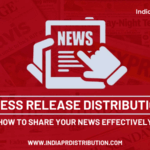 Press releaseAugust 14, 2025Press Release Distribution: How to Share Your News Effectively
Press releaseAugust 14, 2025Press Release Distribution: How to Share Your News Effectively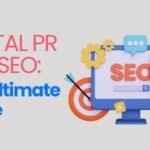 Search OptimizationJuly 29, 2025Digital PR for SEO – The Ultimate Guide to Boosting Your Rankings
Search OptimizationJuly 29, 2025Digital PR for SEO – The Ultimate Guide to Boosting Your Rankings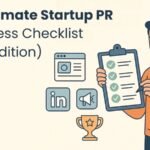 Press Release TipsJuly 24, 2025How to Do PR for Startup: 2025 Readiness Checklist
Press Release TipsJuly 24, 2025How to Do PR for Startup: 2025 Readiness Checklist

